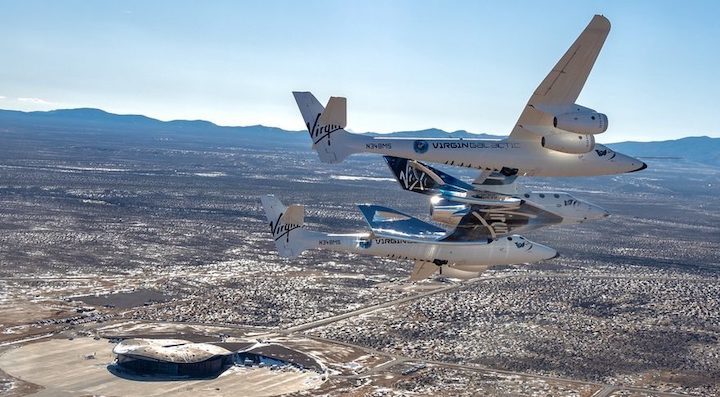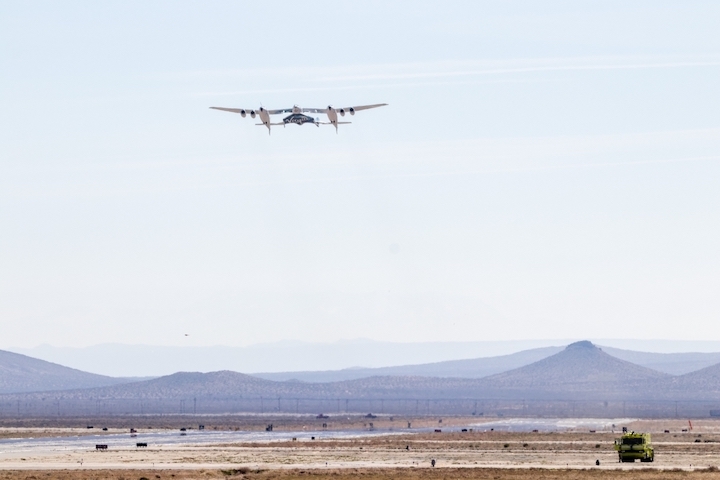15.02.2020

WASHINGTON — Virgin Galactic’s SpaceShipTwo suborbital spaceplane arrived at the company’s spaceport in New Mexico Feb. 13, ready for a final series of test flights before the company starts commercial operations.
The vehicle, named VSS Unity, flew from the Mojave Air and Space Port in California to Spaceport America in southern New Mexico attached to its WhiteKnightTwo carrier aircraft. The company used the flight to perform environmental evaluations of the vehicle and also conduct pilot training and familiarization.
The long-awaited transfer of VSS Unity from California to New Mexico marks the beginning of the final stage of flight tests of the vehicle. Virgin said it plans to perform a series captive carry flights, where SpaceShipTwo remains attached to WhiteKnightTwo, and glide flights, where SpaceShipTwo is released and glides back to the spaceport. Those will be followed by an unspecified number of powered test flights.
“We still have significant work ahead, but we are grateful to all our teammates who have made this day a reality,” George Whitesides, chief executive of Virgin Galactic, said in a statement about the move of SpaceShipTwo to New Mexico.
VSS Unity made its last powered flight nearly a year ago. Since then Virgin Galactic has been making upgrades to the vehicle, including outfitting its cabin for commercial flights.
At the 23rd Commercial Space Transportation Conference here in January, company officials provided few schedule updates about the upcoming testing program, beyond saying that SpaceShipTwo would be transported to New Mexico “soon.”
Beth Moses, chief astronaut instructor at Virgin Galactic and part of the crew of the last powered flight of the vehicle, said at the conference one thing that will be tested on upcoming flights is how the cabin works with several people in it. “We need to increase our passenger density,” she said. “We’re hoping to refine the bespoke training. With four people in the cabin, how does it work out?”
In past investor presentations filed with the U.S. Securities and Exchange Commission, Virgin Galactic has projected beginning commercial service by June. The company has not provided a recent update to those plans, but may do so when the publicly traded company releases its fourth quarter and full year financial results Feb. 25.
Virgin Galactic started trading on the New York Stock Exchange in October after completing a merger with Social Capital Hedosophia, a special-purpose acquisition company that was already traded on that exchange. Virgin’s stock has, in recent weeks, soared to record highs, closing Feb. 13 at $23.66 a share, roughly double the price when it debuted on the exchange in October.
The arrival of SpaceShipTwo at Spaceport America was also a milestone for the state of New Mexico, which announced plans to develop the spaceport in 2005 and has waited patiently through the vehicle’s extended development program. While the runway and main terminal building were completed nearly a decade ago, Virgin Galactic completed the interior of the terminal building and declared it operationally ready only in August.
State officials see Virgin Galactic as an anchor for a growing space industry in the area, which they have dubbed “Space Valley.” Exos Aerospace and Up Aerospace have performed suborbital vertical launches from the spaceport, while SpinLaunch, a secretive company working on an alternative launch technology, is developing a test site there.
“Today marks another step closer: We will have a genuine Space Valley in Southern New Mexico, a hotbed of innovation and achievement and space tourism development,” New Mexico Gov. Michelle Lujan Grisham said in a statement.
Quelle: SN
+++
VSS Unity Arrives at Spaceport America for Commercial Operations

Carried by her mothership VMS Eve, Virgin Galactic’s VSS Unity has arrived at Spaceport America in New Mexico. The move from Mojave, California, signals the beginning of the end of SpaceShipTwo’s test campaign, moving ever closer to operational missions for paying customers.
The WhiteKnightTwo carrier aircraft and SpaceShipTwo spaceplane departed Mojave Air and Space Port on Thursday, conducting testing over California before turning east for the journey to New Mexico.
(Lead Photo Jack Beyer for NSF).
Leaving Home
Mojave has been VSS Unity’s home since it began flight testing in 2016. The rigorous test campaign included four captive carry flights under VMS Eve that year, followed by seven glide flights from 2016 to 2018.
On April 5, 2018, VSS Unity fired its engine for the first time, conducting a powered flight up 25.7 kilometers in altitude. The flight was also the first time VSS Unity went supersonic, reaching a speed of Mach 1.87, or 1.87 times the speed of sound.
Subsequent powered flights on May 29 and July 26 of 2018 reached altitudes of 34.9 km and 52 km respectively, as well as increased speeds of Mach 1.9 and Mach 2.47.

VSS Unity returns to Mojave Air and Space Port after its third powered flight in July 2018 – via Brady Kenniston for NSF
The fourth powered flight on December 13, 2018, accomplished the long-awaited goal of Virgin Galactic’s first trip to space. VSS Unity reached an altitude of 82.7 km, above the American definition of space’s boundary with Earth’s atmosphere at 80 km, and reached a peak speed of Mach 2.9.
The spacecraft’s crew, pilot Mark Stucky and Space Shuttle veteran Frederick Sturckow, became the first people to launch above 80 km from the United States since the final Space Shuttle mission in 2011.
VSS Unity made its second spaceflight, and most recent flight, on February 22, 2019. The vehicle was flown by pilots David Mackay and Michael Masucci, and reached an apogee of 89.9 km and a speed of Mach 3.04. Also on board was Virgin Galactic’s Chief Astronaut Instructor Beth Moses, who became the first person to fly as a passenger aboard SpaceShipTwo.
Just under a year later, VSS Unity has not made another flight since. That may soon change, however, now that the spaceplane is at its operational base at Spaceport America. The remainder of VSS Unity’s test flights will occur from New Mexico, followed by flights for paying customers and scientific research experiments.

VMS Eve and VSS Unity depart Mojave Air and Space Port on their way to Spaceport America Thursday – via Jack Beyer for NSF
Virgin Galactic is not leaving Mojave. Their wholly-owned subsidiary, The Spaceship Company, will continue to construct and test SpaceShipTwo spacecraft and WhiteKnightTwo motherships prior to delivering them to New Mexico. Virgin Galactic share the spaceport with their sister company Virgin Orbit and their LauncherOne program, as well as Stratolaunch’s Roc aircraft and Northrop Grumman’s Pegasus-launching Stargazer.
The SpaceShipTwo program will not be alone in New Mexico, either. EXOS Aerospace’s SARGE suborbital rocket also launches from Spaceport America. The directly adjacent White Sands Missile Range is a primary landing site for Boeing’s Starliner crew capsule.
Growing the Virgin Galactic Fleet
Moving closer to commercial operations in New Mexico means building additional SpaceShipTwo and WhiteKnightTwo vehicles in Mojave. The Spaceship Company has now assembled all of the major structural elements of the next SpaceShipTwo spacecraft. A series of major build milestones culminated in the “Weight on Wheels,” when the spacecraft deployed its landing gear and supported its own weight for the first time.

The next SpaceShipTwo vehicle resting on its own landing gear for the first time, next to VSS Unity in Mojave – via Virgin Galactic
This milestone was reached faster than with VSS Unity, thanks to more efficient manufacturing and assembly processes, as well as experience from building previous spacecraft. The newest vehicle, yet unnamed, is the third SpaceShipTwo built, after the ill-fated VSS Enterprise and the space-flown VSS Unity.
The new spacecraft will now undergo final structural closeouts and the connection of its flight control systems. These steps are a precursor to integrated ground testing and eventual flight tests, to be conducted in Mojave.
A third member of the fleet, and the fourth SpaceShipTwo ever, is also under construction. Over half of the parts for that vehicle have been fabricated.
Partnerships with Investors and Customers
While SpaceShipTwo vehicles are being constructed and conducting flight tests, Virgin Galactic has been securing partnerships to support its commercial operations. $20 million in investments from Boeing’s HorizonX Ventures organization are aimed “to broaden commercial space access and transform global travel technologies.”
Virgin Galactic also merged with Social Capital Hedosophia to create Virgin Galactic Holdings, Inc, which is the world’s first and only publicly traded commercial human spaceflight company, traded on the New York Stock Exchange under the ticker symbol SPCE.

David Mackay, Michael Masucci, and Beth Moses aboard VSS Unity on its second spaceflight in February 2019 – via Virgin Galactic
Virgin Galactic has also signed a contract with the Italian Air Force for a crewed research flight. Three Italian payload specialists will conduct a number of research experiments during a suborbital spaceflight aboard SpaceShipTwo. The crew will leave their passenger seats after engine shutdown and complete the experiments during several minutes of weightlessness.
The payloads are being designed by the Italian Air Force, Virgin Galactic, and the Italian National Research Centre. Topics of study include medical instrumentation to measure the biological effects of microgravity on the human body, and tests to help understand the chemistry of environmentally friendly fuels.
The mission is scheduled to fly as early as 2020, following the completion of VSS Unity’s flight testing at its new home in New Mexico.
Quelle: NS
